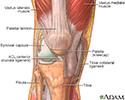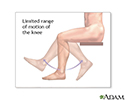Limited range of motion
Limited range of motion is a term meaning that a joint or body part cannot move through its normal range of motion.
Considerations
Motion may be limited because of a problem within the joint, swelling of tissue around the joint, stiffness of the muscles, or pain.
Swelling
Swelling is the enlargement of organs, skin, or other body parts. It is caused by a buildup of fluid in the tissues. The extra fluid can lead to a ...

Causes
A sudden loss of range of motion may be due to:
-
Dislocation
of a joint
Dislocation
A dislocation is a separation of 2 bones where they meet at a joint. Joints are areas where 2 bones come together. A dislocated joint is a joint whe...
 ImageRead Article Now Book Mark Article
ImageRead Article Now Book Mark Article -
Fracture
of an elbow or other joint
Fracture
If more pressure is put on a bone than it can stand, it will split or break. A break of any size is called a fracture. If the broken bone punctures...
 ImageRead Article Now Book Mark Article
ImageRead Article Now Book Mark Article -
Infected joint
(hip is most common in children)
Infected joint
Septic arthritis is inflammation of a joint due to a bacterial or fungal infection. Septic arthritis that is due to the bacteria that cause gonorrhe...
Read Article Now Book Mark Article -
Legg-Calvé-Perthes disease
(in boys 4 to 10 years old)
Legg-Calvé-Perthes disease
Legg-Calve-Perthes disease occurs when the ball of the thigh bone in the hip does not get enough blood, causing the bone to die.
 ImageRead Article Now Book Mark Article
ImageRead Article Now Book Mark Article -
Nursemaid elbow
, an injury to the elbow joint (in young children)
Nursemaid elbow
Nursemaid's elbow is a dislocation of a bone in the elbow called the radius. Dislocation means the bone slips out of its normal position. The injury...
 ImageRead Article Now Book Mark Article
ImageRead Article Now Book Mark Article
Loss of motion may occur if you damage the bones within a joint. This may happen if you have:
-
Ankylosing spondylitis
(chronic form of arthritis)
Ankylosing spondylitis
Ankylosing spondylitis (AS) is a chronic form of arthritis. It mostly affects the bones and joints at the base of the spine where it connects with t...
 ImageRead Article Now Book Mark Article
ImageRead Article Now Book Mark Article - Broken a joint bone in the past
-
Frozen shoulder
Frozen shoulder
Frozen shoulder is a condition in which the shoulder is painful and loses motion because of inflammation.
 ImageRead Article Now Book Mark Article
ImageRead Article Now Book Mark Article -
Osteoarthritis
Osteoarthritis
Osteoarthritis (OA) is the most common joint disorder. It is due to aging and wear and tear on a joint.
 ImageRead Article Now Book Mark Article
ImageRead Article Now Book Mark Article -
Rheumatoid arthritis
Rheumatoid arthritis
Rheumatoid arthritis (RA) is a long-term disease. It leads to inflammation of the joints and surrounding tissues. It can also affect other organs....
 ImageRead Article Now Book Mark Article
ImageRead Article Now Book Mark Article
Brain, nerve, or muscle disorders can damage the nerves, tendons, and muscles, and can cause loss of motion. Some of these disorders include:
-
Cerebral palsy
(group of disorders that involve brain and nervous system functions)
Cerebral palsy
Cerebral palsy is a group of disorders that can involve brain and nervous system functions, such as movement, learning, hearing, seeing, and thinking...
 ImageRead Article Now Book Mark Article
ImageRead Article Now Book Mark Article -
Congenital
torticollis
(wry neck)
Torticollis
Torticollis is a condition in which the neck muscles cause the head to turn or rotate to the side.
 ImageRead Article Now Book Mark Article
ImageRead Article Now Book Mark Article -
Muscular dystrophy
(group of inherited disorders that cause muscle weakness)
Muscular dystrophy
Muscular dystrophy is a group of inherited disorders that cause muscle weakness and loss of muscle tissue, which get worse over time.
 ImageRead Article Now Book Mark Article
ImageRead Article Now Book Mark Article - Stroke or brain injury
-
Volkmann contracture
(deformity of the hand, fingers, and wrist caused by injury to the muscles of the forearm)
Volkmann contracture
Volkmann ischemic contracture is a deformity of the hand, fingers, and wrist caused by injury to the muscles of the forearm.
Read Article Now Book Mark Article
Home Care
Your health care provider may suggest exercises to increase muscle strength and flexibility.
When to Contact a Medical Professional
Make an appointment with your provider if you have difficulty moving or extending a joint.
What to Expect at Your Office Visit
The provider will examine you and ask about your medical history and symptoms.
You may need joint x-rays and spine x-rays . Laboratory tests may be done.
Joint x-rays
This test is an x-ray of a knee, shoulder, hip, wrist, ankle, or other joint.
Spine x-rays
A thoracic spine x-ray is an x-ray of the twelve chest (thoracic) bones (vertebrae). The vertebrae are separated by flat pads of cartilage called di...

Physical therapy may be recommended.
References
Magee DJ. Primary care assessment. In: Magee DJ, ed. Orthopedic Physical Assessment . 6th ed. Philadelphia, PA: Elsevier Saunders; 2014:chap 17.
-
The structure of a joint - illustration
Joints, particularly hinge joints like the elbow and the knee, are complex structures made up of bone, muscles, synovium, cartilage, and ligaments that are designed to bear weight and move the body through space. The knee consists of the femur (thigh bone) above, and the tibia (shin bone) and fibula below. The kneecap (patella) glides through a shallow groove on the front part of the lower thigh bone. Ligaments and tendons connect the three bones of the knee, which are contained in the joint capsule (synovium) and are cushioned by cartilage.
The structure of a joint
illustration
-
Limited range of motion - illustration
When a joint does not move fully and easily in its normal manner it is considered to have a limited range of motion. Motion may be limited by a mechanical problem within the joint, swelling of tissue around the joint, spasticity of the muscles, pain or disease.
Limited range of motion
illustration
-
The structure of a joint - illustration
Joints, particularly hinge joints like the elbow and the knee, are complex structures made up of bone, muscles, synovium, cartilage, and ligaments that are designed to bear weight and move the body through space. The knee consists of the femur (thigh bone) above, and the tibia (shin bone) and fibula below. The kneecap (patella) glides through a shallow groove on the front part of the lower thigh bone. Ligaments and tendons connect the three bones of the knee, which are contained in the joint capsule (synovium) and are cushioned by cartilage.
The structure of a joint
illustration
-
Limited range of motion - illustration
When a joint does not move fully and easily in its normal manner it is considered to have a limited range of motion. Motion may be limited by a mechanical problem within the joint, swelling of tissue around the joint, spasticity of the muscles, pain or disease.
Limited range of motion
illustration
Review Date: 9/22/2016
Reviewed By: C. Benjamin Ma, MD, Professor, Chief, Sports Medicine and Shoulder Service, UCSF Department of Orthopaedic Surgery, San Francisco, CA. Also reviewed by David Zieve, MD, MHA, Isla Ogilvie, PhD, and the A.D.A.M. Editorial team.


